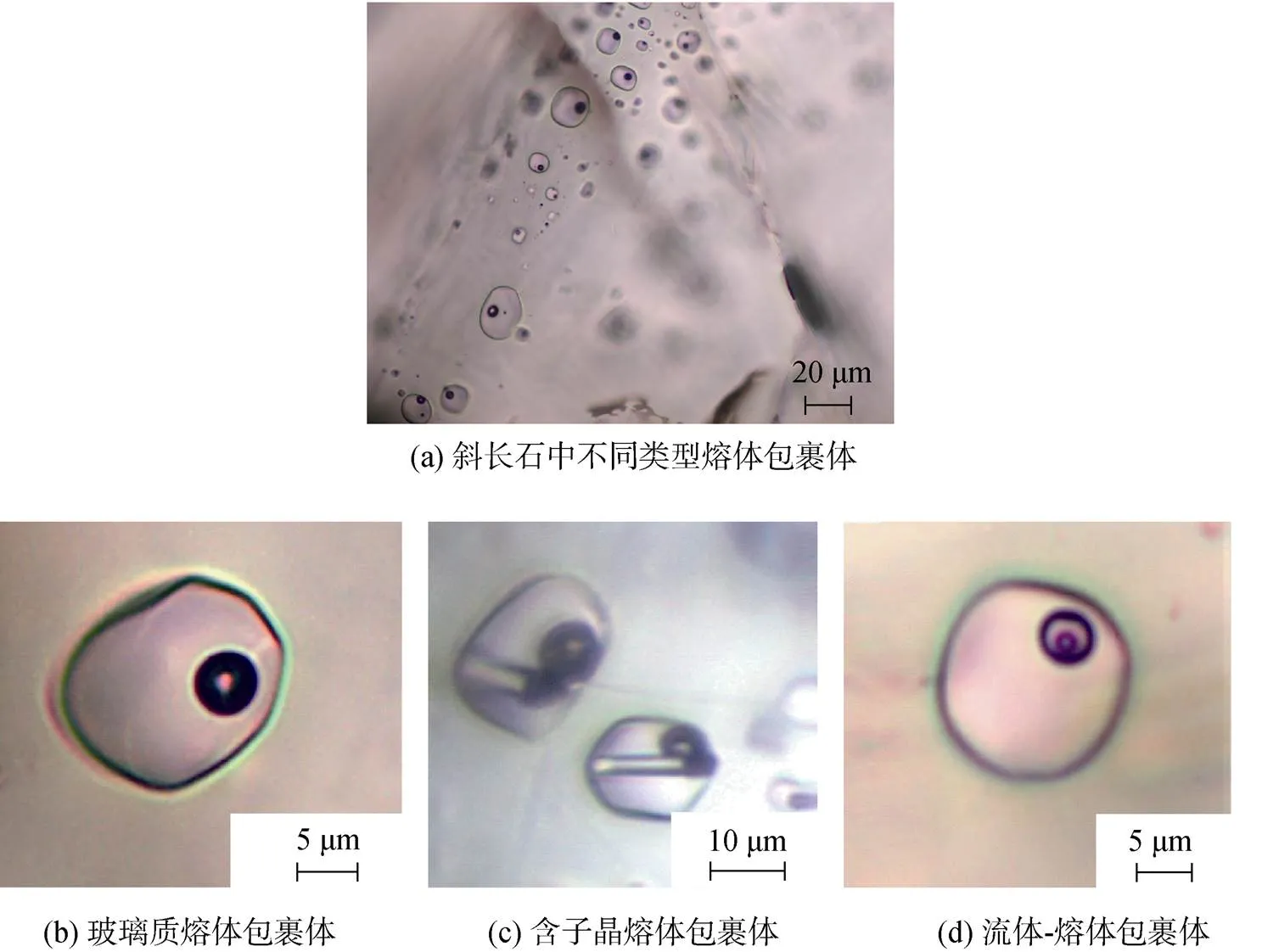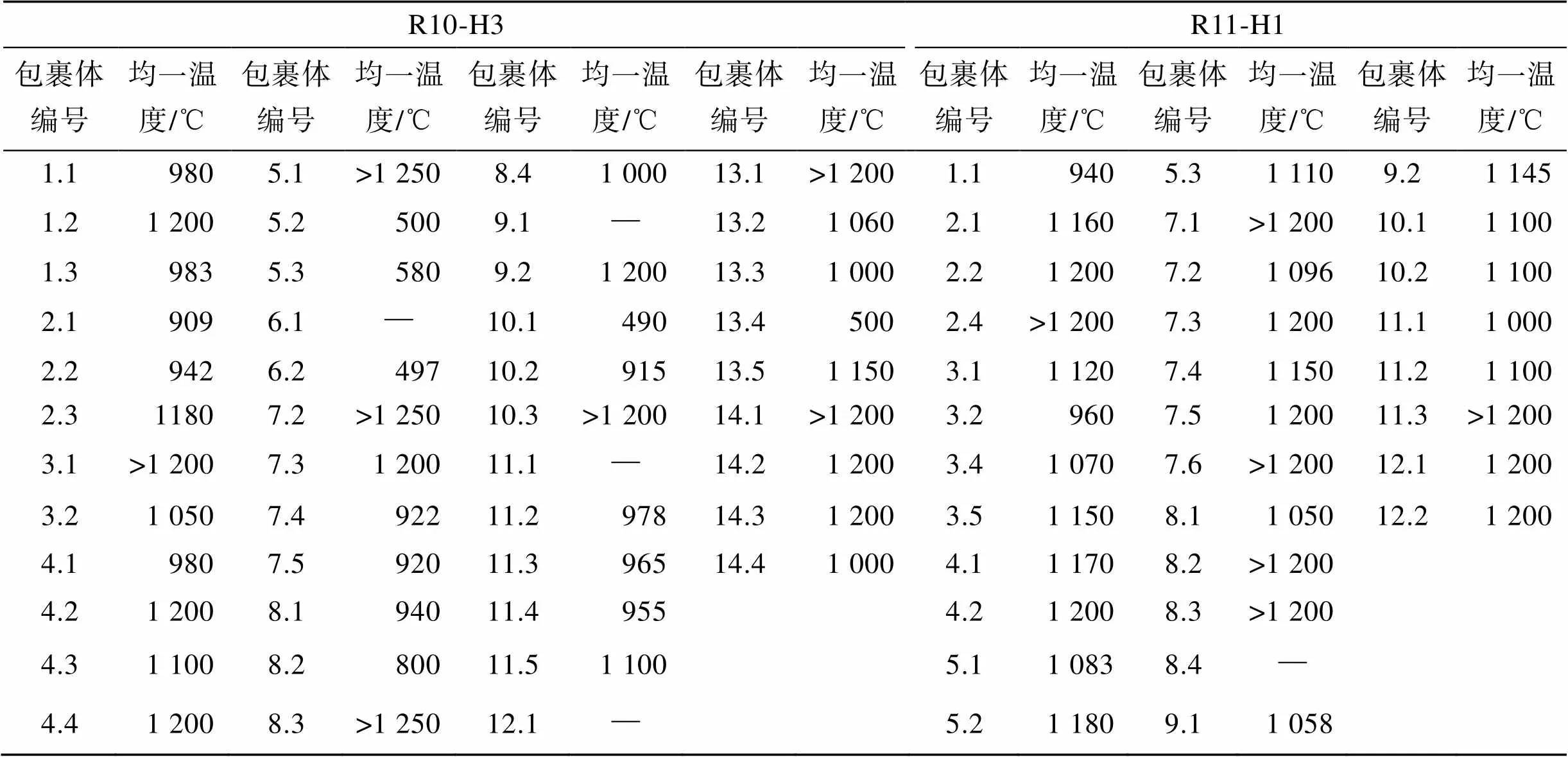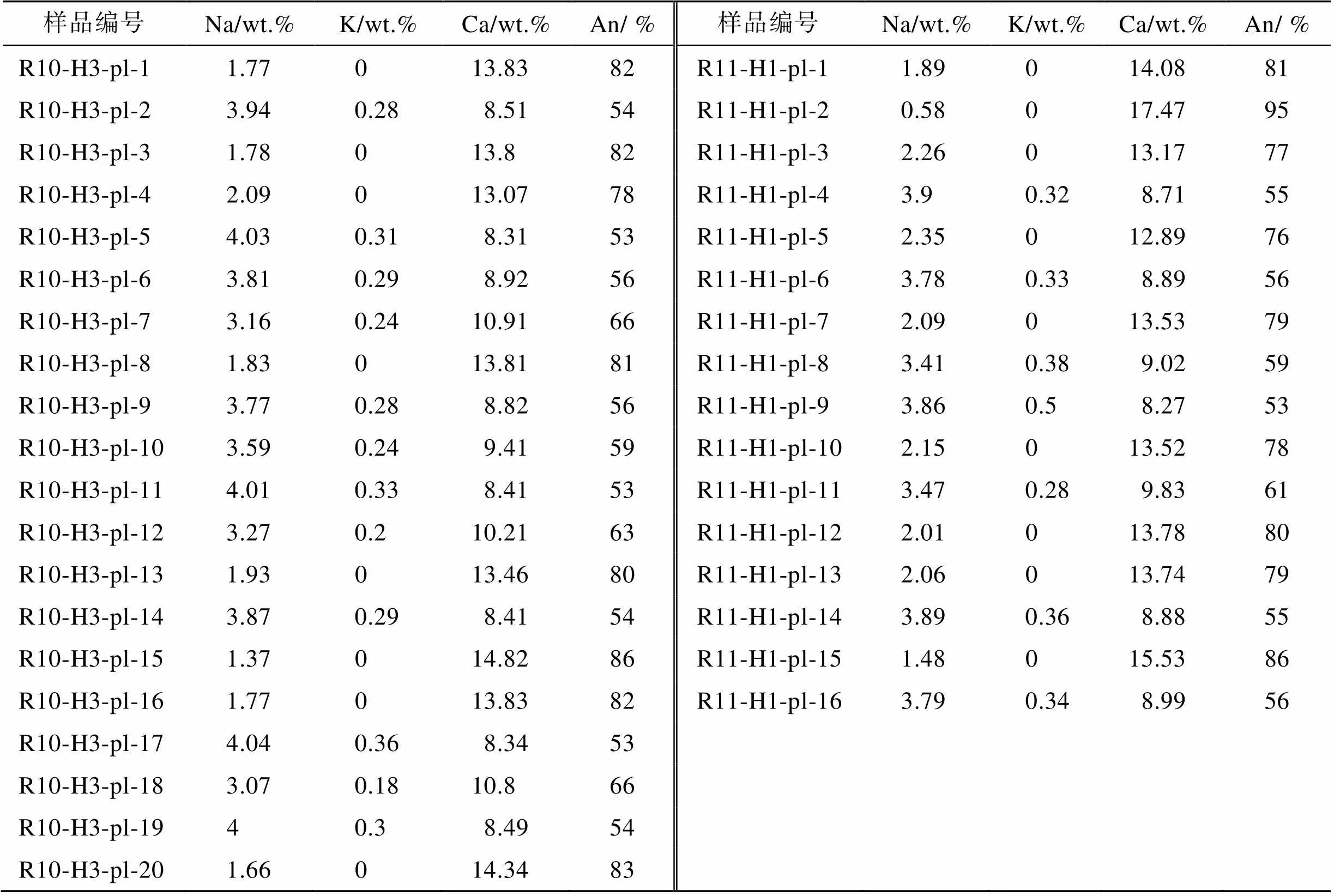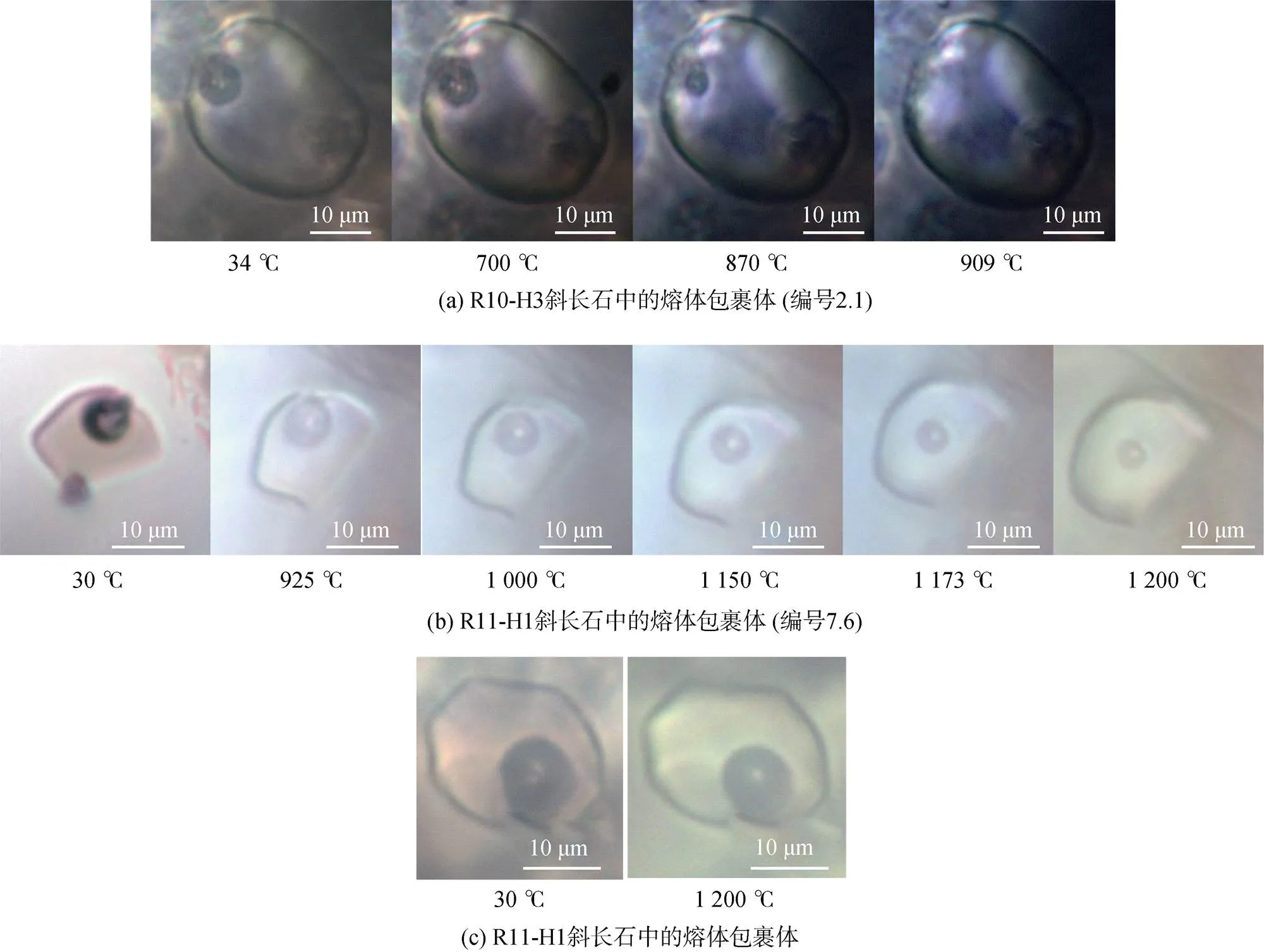冲绳海槽西南部火山岩熔体包裹体的均一温度及对岩浆混合的指示意义
李雪丽, 曾志刚, 李晓辉, 陈祖兴, 张玉祥, 齐海燕
冲绳海槽西南部火山岩熔体包裹体的均一温度及对岩浆混合的指示意义
李雪丽1, 2, 3, 曾志刚1, 2, 3, 李晓辉1, 3, 4, 陈祖兴1, 3, 4, 张玉祥1, 3, 4, 齐海燕1, 2, 4
(1. 中国科学院海洋研究所, 山东 青岛 266071; 2. 中国科学院大学, 北京 100049; 3. 青岛海洋科学与技术试点国家实验室 海洋矿产资源评价与探测技术功能实验室, 山东 青岛 266071; 4. 中国科学院海洋大科学研究中心, 山东 青岛 266071)
冲绳海槽西南部流纹岩(R10-H3)和安山岩(R11-H1)中斜长石发育大量玻璃质熔体包裹体, 安山岩(R11-H1)斜长石中熔体包裹体的均一温度较高(1 050~1 200 ℃), 而流纹岩(R10-H3)斜长石中熔体包裹体存在两个明显不同的均一温度峰值段(900~1 000 ℃, 1 150~1 200 ℃), 呈“双峰”式均一温度特征。流纹岩(R10-H3)和安山岩(R11-H1)中斜长石熔体包裹体呈现的均一温度特征与该斜长石的环带结构及An值变化特征一致, 表明安山岩(R11-H1)中斜长石主要在高温阶段结晶, 而流纹岩(R10-H3)中斜长石经历了两个不同的结晶阶段。结合流纹岩(R10-H3)中斜长石存在明显的环带结构及两种差异较大的An值特征, 作者认为熔体包裹体的“双峰”式均一温度特征指示该地区发生了不同期次岩浆的混合作用。岩浆携带早期高温阶段结晶(1 150~1 200 ℃)的高An值偏基性斜长石向上运移, 注入浅部较低温岩浆中(900~1 000 ℃), 发生岩浆混合作用, 偏基性的斜长石在进入浅部岩浆房后被重新吸收, 形成具有较高均一温度熔体包裹体的核部(高An值), 然后继续结晶出具有较低均一温度熔体包裹体的边部(低An值), 进一步证实冲绳海槽西南部浅部岩浆房内存在着复杂的岩浆混合作用。
斜长石; 熔体包裹体; 均一温度; 岩浆混合
近年来, 国内外学者对冲绳海槽火山岩的地球化学性质、岩浆演化过程以及岩石成因等内容开展了大量研究工作, 也取得了很多显著的成果[1-31]。例如, 一方面通过研究冲绳海槽基性-中性-酸性火山岩全岩及矿物的地球化学特征, 深入探究了该地区岩浆的性质及演化过程, 其中包括分析酸性岩中斜长石的复杂晶体的化学成分, 发现其An值、微量元素含量以及Sr同位素组成变化范围较大, 进而提出了多层岩浆房系统的认识[3, 7, 32]; 另一方面, 通过研究冲绳海槽中部和南部火山岩全岩与橄榄石、辉石和斜长石等矿物及其熔体包裹体的常微量元素和同位素组成特征, 阐述了冲绳海槽下部岩浆房中可能普遍存在岩浆混合现象[1-3, 13, 15-16]。前人的研究多以全岩及矿物为研究对象来探究冲绳海槽的岩浆演化过程, 然而全岩及矿物经历了复杂的分离结晶、同化混染等后期岩浆作用, 致使其地球化学组成在反映原始岩浆的性质及演化过程中存在局限[33-36]。为此, 本文利用火山岩斜长石斑晶中的熔体包裹体作为研究对象, 基于熔体包裹体均一温度探讨冲绳海槽的岩浆演化过程。
熔体包裹体(又称岩浆包裹体)是指在岩浆演化过程中, 各种矿物在其结晶生长时所捕获的微量天然岩浆珠滴, 随着寄主矿物冷却, 它们或淬火凝结成玻璃, 或进一步结晶析出硅酸盐子矿物、金属相和流体相[37-40]。由于熔体包裹体在被捕获之后保持相对独立的演化过程, 不受岩浆混合、结晶分异和同化混染等岩浆后期演化过程的影响, 所以熔体包裹体中保留相对完整的原始岩浆的信息, 为探讨岩浆的性质和演化过程提供了更为可靠的研究对象[33-34, 36, 41-42]。包裹体测温是目前包裹体研究的一个主要内容, 而均一法测温是较为直观可信的方法之一[43]。包裹体的均一温度是在假设包裹体被捕获之后处于封闭体系的前提下, 达到完全均一化状态时的温度, 此温度为其捕获时的最低温度, 也代表寄主矿物的最低结晶温度[43-45]。因此, 研究熔体包裹体的均一温度, 有助于更好的了解包裹体的形成条件, 以及岩浆阶段矿物的结晶温度, 可用于指示矿物的结晶生长条件及岩浆的演化过程[36, 40, 46-47]。
冲绳海槽西南部目前正处于早期扩张阶段[48], 发育的火山岩以英安岩和流纹岩为主, 且斜长石为该类火山岩的主要斑晶矿物[1, 4, 48-49]。前人通过研究该区酸性火山岩中斜长石的化学成分, 认为该区的酸性岩浆房内存在着复杂的岩浆混合过程[1-3, 7]。此前大多研究是从矿物地球化学特征的角度来研究冲绳海槽岩浆的性质及演化过程, 而通过研究矿物中熔体包裹体形成时的温度, 进而探究岩浆的演化过程[30, 43-44]的工作目前在冲绳海槽依然较少。本文拟通过研究冲绳海槽西南部安山岩和流纹岩中斜长石熔体包裹体的均一温度, 结合斜长石的环带结构及化学成分特征, 以期进一步探讨该区浅部岩浆房内的岩浆演化过程。
1 地质背景
冲绳海槽位于西太平洋大陆边缘, 是由菲律宾海板块俯冲到欧亚板块之下形成的一个尚处于弧后扩张早期的年轻弧后盆地[17, 26, 28, 50-51]。作为一个典型的弧后盆地, 冲绳海槽和琉球岛弧以及琉球海沟共同构成了一个完整的沟-弧-盆体系[28], 并且发育大量的海底火山活动与热液活动, 有很高的热流值[31, 51]。冲绳海槽以吐喀喇断裂(130°E)和宫古断裂(127°E)为界分割成北、中、南三段[18, 51], 这三段的构造活动阶段以及火山岩类型有很大差异, 北部目前正在经历地壳的扩张, 主要分布流纹岩、英安岩等酸性火山岩[20]; 中部正在经历扩张裂谷阶段, 火山活动较发育, 主要分布流纹岩、英安岩、安山岩及玄武岩[19, 20, 26], 此外, 中部的岩浆活动还表现出随时间从酸性向基性演化的趋势[29]; 南部处于初步扩张的阶段, 火山岩主要以偏基性的岩石为主, 分布玄武岩和玄武质安山岩[20, 26], 最南端主要分布英安岩和流纹岩[49, 52-53]。冲绳海槽地壳厚度从北部(30 km)向南部(约10 km)递减[1, 48, 54]。然而冲绳海槽西南端为第四纪形成的胚胎裂谷带, 其陆壳厚度(25~30 km)没有明显减薄, 并且该地区的酸性岩浆通常被认为具有显著的地壳混染特征[1, 4, 7, 16, 48-49]。
2 样品及其岩相学特征
研究样品是“科学”号于2016年执行HOBAB4航次, 在冲绳海槽西南部通过电视抓斗获得的两块位置相近的火山岩, 样品棱角分明, 磨圆度较低(图1a、c), 因此判断两块火山岩样品均为原位基岩, 站位信息见表1。其中, R10-H3为灰白色流纹质浮岩, 富斑晶矿物, 斑晶矿物主要为斜长石(20%)、辉石(15%)和角闪石(5%)(图1a、图1b); R11-H1为灰黑色安山岩, 富斑晶矿物, 斑晶矿物包括斜长石(25%)、辉石(10%)和Fe-Ti氧化物(<1%)(图1c、图1d)。流纹岩(R10-H3)、安山岩(R11-H1)中的主要矿物均为自形−半自形的斜长石, 大小为80~1 000 μm。
流纹岩(R10-H3)、安山岩(R11-H1)斜长石矿物中存在大量熔体包裹体(图2), 主要为玻璃质熔体包裹体(图2a), 大小为2~70 μm不等。此外, 还含有少量含子晶玻璃质熔体包裹体(图2b)以及少量流体−熔体包裹体(图2c), 流体相的存在说明岩浆熔体比较富集挥发分[43, 55-57], 流体相部分的大小为3~10 μm。
3 分析方法
3.1 全岩主量元素分析
全岩(R10-H3、R11-H1)主量元素的分析测试是在中国科学院地质与地球物理研究所使用顺序式X射线荧光光谱仪(XRF-1500)完成。首先, 将样品和助熔剂(Li2B4O7-LiNO3)于105 ℃烘箱烘干2 h, 冷却至室温后称取0.6 g粉末样品置于已恒重的小瓷坩埚并放入马弗炉内1 000 ℃下灼烧1 h, 然后冷却30 min称重并计算烧失量(LOI), 随后用玛瑙研钵将样品研磨至200目后倒入6 g助熔剂混合均匀。将样品全部转移至铂金坩埚, 加入4~5滴0.12 g/mL NH4Br, 并在通风橱和丙烷气体环境下将铂金坩埚置于熔样机上进行溶解制备样品玻璃片。最后, 利用X射线荧光光谱仪进行主量元素测试, 测试分析相对标准偏差(RSD%)为0.1%~1%。

图1 冲绳海槽西南部流纹岩(a)和安山岩(c)样品照片及主要矿物透射光显微照片(b、d)

表1 冲绳海槽西南部火山岩样品的取样站位信息
3.2 均一温度分析
首先, 在南京宏创地质勘察技术服务有限公司将全岩(R10-H3、R11-H1)磨制成200 μm厚的两面抛光的包裹体片。然后在偏光显微镜(Axio Scope.A1)下完成包裹体的岩相学观察和拍照, 随后挑选并标记完整、原生且较大的包裹体, 来进行后续均一温度的分析测试。
包裹体的均一温度测试实验是在中国科学院海洋研究所海洋地质与环境重点实验室利用Linkam- TS1400XY显微冷热台进行。首先, 将磨制的包裹体片浸泡在无水乙醇中24 h, 去除树脂胶。之后, 再使用镊子与小刀将包裹体片碎成小块, 这个过程中要尽量注意保持矿物的完整性, 尤其是前期标记的包裹体所在的矿物。然后, 将破碎后的矿物片放在显微冷热台的蓝宝石片上进行均一温度的测试。实验过程中升温速率设置如下: 温度小于500 ℃时, 设置为30 ℃/min; 在500~800 ℃过程中, 设置为20 ℃/min; 在800~1 000 ℃过程中, 设置为10 ℃/min, 并且每升温50 ℃, 恒温15 min; 在1 000~1 250 ℃过程中, 设置为2~5 ℃/min, 并且每升温50 ℃恒温30 min。
3.3 斜长石矿物组成分析
对2块样品(R10-H3、R11-H1)中斜长石矿物的组成分析在中国科学院海洋研究所海洋地质与环境重点实验室使用VEGA3 TESCAN扫描电镜结合Oxford EDS牛津X射线能谱仪(英国)上进行。扫描电镜仪器使用20 kV高压, 发射电流1.4~1.9 nA, 工作距离15 mm。X射线能谱仪使用20 kV激发电压, 斜长石成分定量分析使用石英, 歪长石和黄铁矿作标样。

图2 冲绳海槽西南部火山岩斜长石中不同类型熔体包裹体
4 结果
冲绳海槽西南部全岩样品(R10-H3、R11-H1)主量元素数据列于表2, 斜长石中熔体包裹体的均一温度测试数据列于表3, 斜长石的扫描电镜及X射线能谱点分析及线扫描数据列于表4。

表2 冲绳海槽西南部火山岩全岩主量元素
注:“wt. %”表示质量百分比, 下同。
4.1 全岩地球化学特征
冲绳海槽西南部流纹岩(R10-H3)与安山岩(R11- H1)相比具有较低的CaO(2.26 wt.%)、MgO(0.4 wt.%)和TFe2O3(1.96 wt.%)含量, 较高的SiO2(72.3 wt.%)、Na2O(3.92 wt.%)和K2O(3.02 wt.%)含量。根据冲绳海槽西南部火山岩的全岩主量元素数据(表1)绘制了岩石分类图解(图3)。从硅碱图(图3a)中可以看出两块样品均落在钙碱性序列区域(SiO2: 57.86 wt.%、72.3 wt.%, Na2O+K2O: 3.83 wt.%、6.94 wt.%)。从硅钾图(图3b)中可以看出两块样品均落在中钾区域(SiO2: 57.86 wt.%、72.3 wt.%, K2O: 1.24 wt.%、3.02 wt.%)。两块火山岩全岩地球化学特征均与冲绳海槽南部地区前人已发表的酸性与中性火山岩数据特征一致[4, 58]。
4.2 均一温度特征
在冲绳海槽西南部火山岩斜长石内熔体包裹体的均一实验过程中, 出现了以下三种情况: 第一种情况是随着温度的增加, 熔体包裹体中的气泡不断扩大或缩小, 最终达到均一的状态(如图4a), 此时的温度即均一温度。第二种情况是随着温度的增加, 气泡也在不断扩大或缩小, 但是在达到1 200 ℃的高温, 并恒温30 min后仍不能达到均一的状态(如图4b), 可能是因为熔体包裹体内的玻璃质熔体粘稠度较高, 致使其在恒温时间有限的情况下不能达到完全均一的状态。虽然推测如果加热时间够久, 熔体包裹体最终可以达到均一状态, 但是考虑到持续的高温会对仪器造成损伤, 所以实际操作过程中没有对熔体包裹体进行持久的加温恒温, 这部分的熔体包裹体均一温度计为>1 200 ℃或者>1 250 ℃。第三种情况是随着温度的增加, 包裹体的气泡形态始终不发生变化(图4c), 这种情况可能是因为熔体包裹体已经被破坏, 导致气泡中的成分泄露缺失, 这部分熔体包裹体没有获得均一温度数据。

表3 冲绳海槽西南部火山岩斜长石中熔体包裹体的均一温度数据

表4 冲绳海槽西南部火山岩中斜长石斑晶的X射线能谱点分析
注:An=摩尔Ca/(Ca+Na+K)×100

图3 冲绳海槽西南部岩石分类图解
注: (a)样品硅碱图解[(Na2O+K2O) (wt.%) vs SiO2(wt.%)][59]。碱性与钙碱性序列的边界线数据引自Irvine和Baragar[60]。(b)样品的硅钾图解[K2O (wt.%) vs SiO2(wt.%)][61]。

图4 冲绳海槽西南部火山岩斜长石中熔体包裹体均一过程相态变化图
根据获得的冲绳海槽西南部火山岩斜长石中熔体包裹体的均一温度测量数据(表3)绘制了均一温度频数直方图(图5), 从图5中可以看出流纹岩(R10-H3)有3个较明显的均一温度峰值段: 500~ 600 ℃、900~1 000 ℃和1 150~1 200 ℃。结合偏光显微镜下对熔体包裹体的分布及形态观察发现, 在500~600 ℃低温段均一的熔体包裹体大多分布在矿物裂隙附近, 且形状不规则, 所以判断其为次生熔体包裹体[43]。因此, 流纹岩(R10-H3)斜长石中原生熔体包裹体的均一温度呈现“双峰”式特征, 且相对较低的均一温度峰值段900~1 000 ℃的平均温度为959 ℃, 较高的均一温度峰值段1 150~1 200 ℃的平均温度为1 197.5 ℃。更为重要的是这种“双峰式”均一温度特征出现在流纹岩(R10-H3)中同一个斜长石的熔体包裹体里, 且位于斜长石核部的熔体包裹体均一温度一般比边部的高。安山岩(R11-H1)斜长石中熔体包裹体的均一温度整体都落在大于1 050 ℃的高温均一温度区域(图5), 且从1 050~1 200 ℃均有分布, 1 050~1 200 ℃均一温度段的平均值为1 142 ℃。在900~1 000 ℃较低温度段均一的包裹体个数较少, 仅测到3个。

图5 冲绳海槽西南部火山岩斜长石中熔体包裹体均一温度频数图
注: 图中双峰拟合曲线根据R10-H3斜长石熔体包裹体的两个均一温度峰值段的平均温度绘制
4.3 斜长石矿物组成特征
利用扫描电镜结合X射线能谱仪对冲绳海槽西南部流纹岩(R10-H3)和安山岩(R11-H1)中斜长石的组成特征进行分析。从点分析结果(表4)和斜长石的An值频数分布图(图6)中可以看出流纹岩(R10-H3)中斜长石的成分变化非常大, An值范围为53~86 (An=摩尔Ca/(Ca+Na+K)×100), 并且呈“双峰”式分布; 安山岩(R11-H1)中斜长石的成分变化也很大, An值范围为53~95, 但是“双峰”特征不明显, 多数为高An值。从图7a中可以看出流纹岩(R10-H3)中斜长石有明显的明暗环带结构, 且亮灰白色部分面积小于暗灰色部分面积。从相应的元素线扫描结果上(图7b)也可以看出Ca元素含量变化较大, 结合点分析(表4)发现BSE图中斜长石亮灰白色部分An高(63~86), 说明这部分斜长石偏基性, 且一般位于斜长石核部; 暗灰色部分An低(53~59), 说明这部分斜长石偏酸性, 一般位于斜长石边部。安山岩(R11-H1)中斜长石也有明暗环带结构(图7c), 但是不明显, Ca元素含量变化不大(图7d), 只有边部一小部分呈暗灰色(An=53~59), 其余大部分为高An(61~95)的亮灰白色。

图6 冲绳海槽西南部火山岩中斜长石An值频数分布图

图7 冲绳海槽西南部火山岩中斜长石斑晶的BSE(背散射)照片以及对应的线扫描Ca含量计数图
5 讨论
5.1 均一温度对斜长石不同结晶阶段的指示
此前, 有研究利用矿物-熔体温度计公式[62]来计算冲绳海槽地区火山岩中斑晶矿物的结晶温度, 从而了解岩浆演化过程中矿物结晶的温度变化情况[1, 7, 15, 63]。通过矿物温度计公式计算得到冲绳海槽中部流纹岩中正环带斜长石的结晶温度为895± 2 ℃, 反环带斜长石低Ca元素含量核部的结晶温度为876± 3 ℃; 安山岩(R11-H1)中高Ca元素含量斜长石的结晶温度为1 102±2 ℃, 低Ca元素含量斜长石的结晶温度为897±7 ℃[60]。然而矿物温度计的不足之处在于其是根据经验公式, 并且基于矿物-熔体平衡状态推导计算得到的温度数据, 往往误差较大, 难以精确代表真实的矿物结晶温度[15, 59, 64-65]。因此, 与矿物温度计方法相比, 矿物中熔体包裹体的均一温度测试为估计岩浆体系演化过程中不同阶段矿物的结晶温度提供了更加直观准确的数据, 但前提是所测熔体包裹体为完整无损的原生包裹体, 并且被捕获后的主晶成分保持不变[38, 40, 66]。因此, 我们根据测得的流纹岩(R10-H3)和安山岩(R11-H1)斜长石中原生熔体包裹体的均一温度数据探讨了中酸性火山岩中斜长石的不同结晶阶段。
从图5中可以看出, 安山岩(R11-H1)斜长石中熔体包裹体的均一温度大多落在大于1 050 ℃的高温区域, 并且呈现出从1 200 ℃到1 050 ℃连续降温的趋势, 此外, 还有少量熔体包裹体在较低温度发生均一(900~1 000 ℃), 说明安山岩(R11-H1)中的斜长石主要结晶阶段为>1 050 ℃的高温环境, 也有一小部分斜长石在较低温度(900~1 000 ℃)下发生了结晶[30, 67]。结合BSE图像和成分分析(图7c、图7d, 表4)可以看出安山岩(R11-H1)中斜长石几乎全部为高An值(61~95), 只有边部一小部分为低An值(53~59), 而且高An值部分形状规则, 与低An值部分形状一致, 说明斜长石并未受到溶蚀[68-70], 而是经历了正常的结晶生长过程, 边部的低An值部分是由于结晶后期岩浆快速冷凝而形成[71], 这表明安山岩(R11-H1)中斜长石主要在大于1 050 ℃的高温阶段结晶。
流纹岩(R10-H3)斜长石中的熔体包裹体呈现明显的“双峰”式均一温度特征(图5), 而且这种“双峰”式均一温度特征出现在同一个斜长石的不同部位的熔体包裹体中, 即核部为高温均一(1 150~1200 ℃,平均温度1 197.5 ℃)的熔体包裹体, 边部为较低温度均一(900~1 000 ℃, 平均温度959 ℃)的熔体包裹体。结合BSE图像和成分分析(图7a、图7b, 表4)也可以看出斜长石有明显的明暗环带结构, 核部为高An值(63~86), 边部为低An值(53~59), 与熔体包裹体“双峰”式均一温度特征相对应, 表明流纹岩(R10-H3)中的斜长石有两个明显不同的结晶阶段, 早期高温环境形成偏基性高An值的核部, 然后再在较低温环境形成酸性低An值的边部[72-73]。
5.2 “双峰”式均一温度对岩浆演化的指示
对于冲绳海槽西南部流纹岩(R10-H3)中斜长石的熔体包裹体呈现“双峰”式均一温度特征, 前人[30]通过对冲绳海槽中部浮岩中斜长石的熔体包裹体进行均一法测温也发现其存在“双峰式”均一温度的特征, 并认为是酸性岩浆在上升过程中携带了早期形成的基性斜长石[30, 67], 但是这个原因无法解释本文流纹岩样品中有些斜长石里既有高均一温度的熔体包裹体又有较低均一温度的熔体包裹体存在的现象, 并且从斜长石的BSE图以及相应的成分分析(图7a、图7b, 表4)中也可以看出同一斜长石中存在两种差异较大的An值(53~59, 63~86)。因此, 我们认为可能是不同期次的岩浆混合作用造成的流纹岩(R10-H3)中斜长石熔体包裹体的“双峰”式均一温度特征[1, 4, 15-16, 74, 76]。高An值斜长石中发育较高均一温度的熔体包裹体, 其对应的岩浆房温度为1 150~1 200 ℃, 低An值斜长石中发育较低均一温度的熔体包裹体, 其对应的岩浆房温度为 900~1 000 ℃。
由此可见, 冲绳海槽西南部地区的岩浆后期演化过程较为复杂, 根据本文对流纹岩斜长石中熔体包裹体的“双峰”式均一温度特征研究, 结合前人对该地区的岩石矿物地球化学特征研究结果, 认为冲绳海槽西南地区下部岩浆房内发育复杂的岩浆混合作用。基性岩浆携带早期形成的高An斜长石向上运移, 注入浅部岩浆房内并与其发育的酸性岩浆发生混合[1, 4, 15-16, 74-78], 偏基性的斜长石在进入浅部岩浆房(发育酸性岩浆)后被重新吸收形成高An的核部并继续生长形成低An的边部[1, 79-80]。
6 结论
本文通过研究冲绳海槽西南部的安山岩(R11- H1)和流纹岩(R10-H3)中斜长石的熔体包裹体的相态分布特征、均一温度以及寄主矿物斜长石的环带结构和组成成分特征, 为认识该地区的岩浆演化过程提供了新的视角, 获得以下结论:
1) 安山岩(R11-H1)和流纹岩(R10-H3)中斜长石发育大量玻璃质熔体包裹体, 安山岩(R11-H1)斜长石中的熔体包裹体均一温度主要落在高温区域, 仅有少数熔体包裹体的均一温度较低, 与其斜长石的An值变化特征一致, 即大部分安山岩(R11-H1)中斜长石的An值较高, 只有一小部分的斜长石其边部的An值较低, 说明该安山岩(R11-H1)中的斜长石主要是在高温阶段结晶。流纹岩(R10-H3)斜长石中的熔体包裹体有两个明显不同的均一温度峰值段, 呈“双峰”式均一温度特征, 且流纹岩(R10-H3)中斜长石的核部和边部有差异较大的两种An值, 说明该流纹岩(R10-H3)中斜长石经历了两个不同的结晶阶段。
2) 流纹岩(R10-H3)中斜长石的熔体包裹体呈现“双峰”式均一温度特征是由于不同期次的岩浆在喷发之前发生了混合作用。基性岩浆携带早期在高温环境形成的具高An值的偏基性斜长石向上运移, 注入浅部岩浆房, 两者发生混合作用, 偏基性的斜长石在进入浅部岩浆房后被重新吸收形成具高An值的核部, 然后继续结晶生长, 在相对低温的环境形成具低An值的边部。由此可见, 冲绳海槽西南部浅部岩浆房内存在复杂的岩浆混合作用。
致谢: 感谢2016年HOBAB4航次“科学”号以及采集样品人员为本次研究提供宝贵的火山岩样品, 感谢中国科学院地质与地球物理研究所岩矿制样与分析实验室的张丹萍实验师与薛丁帅工程师协助完成XRF测试分析实验, 感谢南京宏创地质勘察技术服务有限公司为我们制备本次研究样品的薄片, 感谢中国石油大学地球科学与技术学院陈勇教授与冯艳伟博士为本文包裹体的相态特征鉴定及成分分析提供建议。
[1] Chen Zuxing, Zeng Zhigang, Wang Xiaoyuan, et al. Element and Sr isotope zoning in plagioclase in the dacites from the southwestern Okinawa Trough: Insights into magma mixing processes and time scales[J]. Lithos, 2020, 376-377: 105776.
[2] Chen Zuxing, Zeng Zhigang, Wang Xiaoyuan, et al. U-Th/He dating and chemical compositions of apatite in the dacite from the southwestern Okinawa Trough: Implications for petrogenesis[J]. Journal of Asian Earth Sciences, 2018, 161: 1-13.
[3] Chen Zuxing, Zeng Zhigang, Wang Xiaoyuan, et al. Mineral chemistry indicates the petrogenesis of rhyolite from the southwestern okinawa trough[J]. Journal of Ocean University of China, 2017, 16(6): 1097-1108.
[4] Chen Zuxing, Zeng Zhigang, Yin Xuebo, et al. Petrogenesis of highly fractionated rhyolites in the southwestern Okinawa Trough: Constraints from whole-rock geochemistry data and Sr-Nd-Pb-O isotopes[J]. Geological Journal, 2019, 54(1): 316-332.
[5] Guo Feng, Li Hongxia, Fan Weiming, et al. Variable sediment flux in generation of Permian subduction- related mafic intrusions from the Yanbian region, NE China[J]. Lithos, 2016, 261: 195-215.
[6] Guo Kun, Zhai Shikui, Yu Zenghui, et al. Sr-Nd-Pb isotopic geochemistry of phenocrysts in pumice from the central Okinawa Trough[J]. Geological Journal, 2016, 51: 368-375.
[7] Guo Kun, Zhai Shikui, Wang Xiaoyuan, et al. The dynamics of the southern Okinawa Trough magmatic system: New insights from the microanalysis of the An contents, trace element concentrations and Sr isotopic compositions of plagioclase hosted in basalts and silicic rocks[J]. Chemical Geology, 2018, 497: 146-161.
[8] Hoang N, Uto K. Upper mantle isotopic components beneath the Ryukyu arc system: Evidence for ‘back-arc’ entrapment of Pacific MORB mantle[J]. Earth and Planetary Science Letters, 2006, 249(3-4): 229-240.
[9] Honma H, Kusakabe M, Kagami H, et al. Major and trace-element chemistry and D/H,18O/16O,87Sr/86Sr and143Nd/144Nd ratios of rocks from the spreading center of the Okinawa Trough, a marginal back-arc basin[J]. Geochemical Journal, 1991, 25(2): 121-136.
[10] Ishizuka H, Kawanobe Y, Sakai H. Petrology and geochemistry of volcanic-rocks dredged from the Okinawa Trough, an active back-arc basin[J]. Geochemical Journal, 1990, 24(2): 75-92.
[11] Li Xiaohui, Ren Zhongyuan, Zeng Zhigang, et al. Petrogenesis of middle Okinawa Trough volcanic rocks: Constraints from lead isotopes in olivine-hosted melt inclusions[J]. Chemical Geology, 2020, 543, 119600.
[12] Li Xiaohui, Zeng Zhigang, Chen Shuai, et al. Geochemical and Sr-Nd-Pb isotopic compositions of volcanic rocks from the Iheya Ridge, the middle Okinawa Trough: implications for petrogenesis and a mantle source[J]. Acta Oceanologica Sinica, 2018, 37(1): 73-88.
[13] Li Xiaohui, Zeng Zhigang, Dan Wei, et al. Source lithology and crustal assimilation recorded in low delta O-18 olivine from Okinawa Trough, back-arc basin[J]. Lithos, 2020, 360: 119600.
[14] Li Xiaohui, Zeng Zhigang, Wang Xiaoyuan, et al. Petrogenesis of basalt from the middle Okinawa Trough: New insights from olivine-hosted melt inclusions[J]. Geological Journal, 2018, 53(6): 3129-3146.
[15] Li Xiaohui, Zeng Zhigang, Yang Huixin, et al. Integrated major and trace element study of clinopyroxene in basic, intermediate and acidic volcanic rocks from the middle Okinawa Trough: Insights into petrogenesis and the influence of subduction component[J]. Lithos, 2020, 352/353: 105320.
[16] Li Xiaohui, Zeng Zhigang, Yang Huixin, et al. Geochemistry of silicate melt inclusions in middle and southern Okinawa Trough rocks: Implications for petrogenesis and variable subducted sediment component injection[J]. Geological Journal, 2019, 54(3): 1160- 1189.
[17] Shinjo R. Geochemistry of high Mg andesites and the tectonic evolution of the Okinawa Trough Ryukyu arc system[J]. Chemical Geology, 1999, 157(1/2): 69-88.
[18] Shinjo R, Chung S L, Kato Y, et al. Geochemical and Sr-Nd isotopic characteristics of volcanic rocks from the Okinawa Trough and Ryukyu Arc: Implications for the evolution of a young, intracontinental back arc basin[J]. Journal of Geophysical Research-Solid Earth, 1999, 104(B5): 10591-10608.
[19] Shinjo R, Kato Y. Geochemical constraints on the origin of bimodal magmatism at the Okinawa Trough, an incipient back-arc basin[J]. Lithos, 2000, 54(3/4): 117-137.
[20] Yan Quanshu, Shi Xuefa. Petrologic perspectives on tectonic evolution of a nascent basin (Okinawa Trough) behind Ryukyu Arc: A review[J]. Acta Oceanologica Sinica, 2014, 33(4): 1-12.
[21] Yu Zenghui, Zhai Shikui, Guo Kun, et al. Helium isotopes in volcanic rocks from the Okinawa Trough impact of volatile recycling and crustal contamination[J]. Geological Journal, 2016, 51: 376-386.
[22] Zeng Zhigang, Yu Shaoxiong, Wang Xiaoyuan, et al. Geochemical and isotopic characteristics of volcanic rocks from the northern East China Sea shelf margin and the Okinawa Trough[J]. Acta Oceanologica Sinica, 2010, 29(4): 48-61.
[23] Zhang Yuxiang, Zeng Zhigang, Chen Shuai, et al. New insights into the origin of the bimodal volcanism in the middle Okinawa Trough: not a basalt-rhyolite differentiation process[J]. Frontiers of Earth Science, 2018, 12(2): 325-338.
[24] Zhang Yuxiang, Zeng Zhigang, Wang Xiaoyuan, et al. Factors controlling the geochemical differences between two types of rhyolites in the middle Okinawa Trough[J]. Geosciences Journal, 2020, 24(1): 35-48.
[25] Zhang Yuxiang, Zeng Zhigang, Yin Xuebo, et al. Petrology and mineralogy of pumice from the Iheya North Knoll, Okinawa Trough: Implications for the differentiation of crystal-poor and volatile-rich melts in the magma chamber[J]. Geological Journal, 2018, 53(6): 2732-2745.
[26] 黄朋, 李安春, 蒋恒毅. 冲绳海槽北、中段火山岩地球化学特征及其地质意义[J]. 岩石学报, 2006, 22(6): 1703-1712.
Huang Peng, Li Anchun, Jiang Hengyi. Geochemical features and their geological implications of volcanic rocks from the northern and middle Okinawa Trough[J]. Acta Petrologica Sinica, 2006, 22(6): 1703-1712.
[27] 李巍然, 杨作升, 王永吉, 等. 冲绳海槽火山岩岩石特征及其地质意义[J]. 岩石学报, 1997, 13(4): 538-550.
Li Weiran, Yang Zuosheng, Wang Yongji, et al. The petrochemical features of the volcanic rocks in Okinawa Trough and their geological significance[J]. Acta Petrologica Sinica, 1997, 13(4): 538-550.
[28] 翟世奎, 陈丽蓉, 张海启. 冲绳海槽的岩浆作用与海底热液活动[M]. 北京: 海洋出版社, 2001: 1-8.
Zhai Shikui, Chen Lirong, Zhang Haiqi. Magmatism and hydrothermal activity in the Okinawa Trough[M]. Beijing: China Ocean Press, 2001: 1-8.
[29] 翟世奎, 毛雪瑛. 冲绳海槽早期扩张作用中岩浆活动的演化[J]. 海洋学报, 1994, 16(3): 61-73.
Zhai Shikui, Mao Xueying. The evolution of magmatic activity during the early expansion of the Okinawa Trough[J]. Haiyang Xuebao, 1994, 16(3): 61-73.
[30] 翟世奎, 张杰, 张明书, 等. 冲绳海槽浮岩包裹体的测温试验[J]. 海洋与湖沼, 2001, 32(1): 67-73.
Zhai Shikui, Zhang Jie, Zhang Mingshu, et al. Temperature measurement test of pumice inclusions in Okinawa Trough[J]. Oceanologia et Limnologia Sinica, 2001, 32(1): 67-73.
[31] 赵广涛, 翟世奎, 王文正, 等. 冲绳海槽火山岩—揭示弧后盆地早期扩张动力学过程的钥匙[J]. 海洋地质与第四纪地质, 2001, 21(3): 119-122.
Zhao Guangtao, Zhai Shikui, Wang Wenzheng, et al. Volcanic rocks in the Okinawa Trough: The key to reveal the dynamic process of early expansion of the back arc basin[J]. Marine Geology & Quaternary Geology, 2001, 21(3): 119-122.
[32] 翟世奎, 陈丽蓉, 王镇, 等. 冲绳海槽浮岩岩浆活动模式浅析[J]. 海洋地质与第四纪地质, 1997, 17(1): 59-66.
Zhai Shikui, Chen Lirong, Wang Zhen, et al. Primary analysis on pumice magmatism model of the Okinawa Trough[J]. Marine Geology and Quaternary Geology, 1997, 17(1): 59-66.
[33] Sobolev A V, Chaussidon M. H2O concentrations in primary melts from supra-subduction zones and mid-ocean ridges: Implications for H2O storage and recycling in the mantle[J]. Earth and Planetary Science Letters, 1996, 137(1/4): 45-55.
[34] 丁一, 刘吉强, 宗统, 等. 熔体包裹体挥发分应用的研究进展[J]. 岩石矿物学杂志, 2019, 38(6): 897-913.
Ding Yi, Liu Jiqiang, Zong Tong, et al. Research progress on the application of volatiles from melt inclusions[J]. Acta Petrologica et Mineralogica, 2019, 38(6): 897-913.
[35] 任钟元, 张乐, 吴亚东, 等. 熔体包裹体在镁铁质火山岩成因研究中的应用[J]. 矿物岩石地球化学通报, 2018, 37(3): 395-413.
Ren Zhongyuan, Zhang Le, Wu Yadong, et al. Application of melt inclusions in the genetic research of mafic volcanic rocks[J]. Bulletin of Mineralogy, Petrology and Geochemistry. 2018, 37(3): 395-413.
[36] 王蝶, 卢焕章, 单强. 岩浆熔体包裹体研究进展[J]. 岩石学报, 2017, 33(2): 653-666.
Wang Die, Lu Huanzhang, Shan Qiang. Research progress of magma melt inclusions[J]. Acta Petrologica Sinica, 2017, 33(2): 653-666.
[37] Qin Z W, Lu F Q, Anderson A T. Diffusive reequilibration of melt and fluid inclusions[J]. American Mineralogist, 1992, 77(5/6): 565-576.
[38] Roedder E. Origin and significance of magmatic inclusions[J]. Bulletin de Mineralogie, 1979, 102(5): 487-510.
[39] Sorby H C. On the microscopical, structure of crystals, indicating the origin of minerals and rocks[J]. Quarterly Journal of the Geological Society, 1858, 14(1/2): 453-500.
[40] Roedder E. The origin of inclusions[J]. Reviews in Mineralogist, 1984, 77(5/6): 565-576.
[41] Esposito R, Hunter J, Schiffbauer J D, et al. An assessment of the reliability of melt inclusions as recorders of the pre-eruptive volatile content of magmas[J]. American Mineralogist, 2014, 99(5/6): 976-998.
[42] Metrich N, Wallace P J. Volatile abundances in basaltic magmas and their degassing paths tracked by melt inclusions[J]. Reviews in Mineralogy and Geochemistry, 2008, 69(1): 363-402.
[43] 卢焕章. 流体包裹体[M]. 北京: 科学出版社, 2004: 172-195.
Lu Huanzhang. Fluid inclusions[M]. Beijing: Science Press, 2004: 172-195.
[44] 于增慧. 冲绳海槽火山岩中岩浆包裹体及气体同位素组成研究[D]. 青岛: 中国科学院海洋研究所, 2000: 17-23.
Yu Zenghui. Study on magma inclusions and gas isotopic composition in volcanic rocks of Okinawa Trough[D]. Qingdao: Institute of Oceanology, Chinese Academy of Sciences, 2000: 17-23.
[45] 何知礼. 包体矿物学[M]. 北京: 地质出版社, 1982: 304.
He Zhili. Inclusion mineralogy[M]. Beijing: Geological Publishing House, 1982: 304.
[46] Roedder E. Fluid inclusion evidence for immiscibility in magmatic differentiation[J]. Geochimica et Cosmochimica Acta, 1992, 56(1): 5-20.
[47] Touret J L R, Frezzotti M L. Magmatic remnants in plutonic rocks[J]. Bulletin De La Societe Geologique De France, 1993, 164(2): 229-242.
[48] Sibuet J C, Deffontaines B, Hsu S K, et al. Okinawa trough backarc basin: Early tectonic and magmatic evolution[J]. Journal of Geophysical Research- Solid Earth, 1998, 103(B12): 30245-30267.
[49] Chung S L, Wang S L, Shinjo R, et al. Initiation of arc magmatism in an embryonic continental rifting zone of the southernmost part of Okinawa Trough[J]. Terra Nova, 2000, 12(5): 225-230.
[50] Kimura, Masaaki. Back-arc rifting in the Okinawa Trough[J]. Marine Petroleum Geology, 1985, 2(3): 222- 240.
[51] 金翔龙, 喻普之. 冲绳海槽的构造特征与演化[J]. 中国科学: 化学, 1987, 17(2): 196-203.
Jin Xianglong, Yu Puzhi. The structural features and evolution of the Okinawa Trough[J]. Scientia Sinica (Chimica), 1987, 17(2): 196-203.
[52] 陈祖兴, 曾志刚, 王晓媛, 等. 冲绳海槽南部流纹岩中角闪石的化学特征及其对岩石成因的指示[J]. 海洋学报, 2017, 39(12): 74-89.
Chen Zuxing, Zeng Zhigang, Wang Xiaoyuan, et al. Geochemical characteristics of amphiboles in the rhyolite from the southern Okinawa Trough, and its implication for petrogenesis[J]. Haiyang Xuebao, 2017, 39(12): 74-89.
[53] Chen C H, Typhoon L, Shieh Y, et al. Magmatism at the onset of back-arc basin spreading in the Okinawa Trough[J]. Journal of Volcanology and Geothermal Research, 1995, 69(3/4): 313-322.
[54] Arai R, Kodaira S, Yuka K, et al. Crustal structure of the southern Okinawa Trough: Symmetrical rifting, submarine volcano, and potential mantle accretion in the continental back-arc basin[J]. Journal of Geophysical Research-Solid Earth, 2017, 122(1): 622-641.
[55] Hedenquist J W, Lowenstern J B. The role of magmas in the formation of hydrothermal ore-deposits[J]. Nature, 1994, 370(6490): 519-527.
[56] Lowenstern J B. Dissolved volatile concentrations in an ore-forming magma[J]. Geology, 1994, 22(10): 893-896.
[57] Lowenstern J B. Chlorine, fluid immiscibility, and degassing in peralkaline magmas from pantelleria, italy[J]. American Mineralogist, 1994, 79(3/4): 353-369.
[58] Shu Y, Nielsen S G, Zeng Z, et al. Tracing subducted sediment inputs to the Ryukyu arc-Okinawa Trough system: Evidence from thallium isotopes[J]. Geochimica et Cosmochimica Acta, 2017, 217: 462-491.
[59] Lebas M J, Lemaitre R W, Streckeisen A, et al. A chemical classification of volcanic-rocks based on the total alkali silica diagram[J]. Journal of Petrology, 1986, 27(3): 745-750.
[60] Irvine T N, Baragar W R A. A guide to the chemical classification of the common volcanic rocks[J]. Canadian Journal of Earth Sciences, 1971, 8(5): 523-548.
[61] Peccerillo A, Taylor S R. Geochemistry of eocene calc-alkaline volcanic rocks from the Kastamonu area, Northern Turkey[J]. Contributions to Mineralogy & Petrology, 1976, 58(1): 63-81.
[62] Putirka K. Thermometers and barometers for volcanic systems[J]. Reviews in Mineralogy and Geochemistry, 2008, 69: 61-120.
[63] 张玉祥. 冲绳海槽中段中酸性火山岩的特征及其记录的岩浆过程[D]. 青岛: 中国科学院大学(中国科学院海洋研究所), 2019: 79-83.
Zhang Yuxiang. Characteristics of the intermediate- silicic volcanic rocks and their magmatic process records in the middle Okinawa Trough[D]. Qingdao: University of Chinese Academy of Sciences (Institute of Oceanology, Chinese Academy of Sciences), 2019: 79-83.
[64] Nimis P. A clinopyroxene geobarometer for basaltic systems based on crystal-structure modeling[J]. Contributions to Mineralogy and Petrology, 1995, 121(2): 115-125.
[65] Nimis P, Taylor W R. Single clinopyroxene thermobarometry for garnet peridotites. Part I. Calibration and testing of a Cr-in-Cpx barometer and an enstatite-in-Cpx thermometer[J]. Contributions to Mineralogy and Petrology, 2000, 139(5): 541-554.
[66] Danyushevsky L V, Mcneill A W, Sobolev A V. Experimental and petrological studies of melt inclusions in phenocrysts from mantle-derived magmas: an overview of techniques, advantages and complications[J]. Chemical Geology, 2002, 183(1/4): 5-24.
[67] 翟世奎. 冲绳海槽浮岩的分布及其斑晶矿物学特征[J]. 海洋与湖沼, 1986, 17(6): 504-512.
Zhai Shikui. The distribution and mineralogical characteristics of the pumice in the Okinawa Trough[J]. Oceanologia et Limnologia Sinica, 1986, 17(6): 504-512.
[68] 鄢全树, 石学法, 王昆山, 等. 南海新生代碱性玄武岩主量, 微量元素及Sr-Nd-Pb同位素研究[J]. 中国科学(D辑), 2008, 38(1): 56-71.
Yan Quanshu, Shi Xuefa, Wang Kunshan, et al., Study on the Major Content, Trace Elements and Sr-Nd- Pb Isotopes of Cenozoic Alkaline Basalts in South China Sea[J]. Science in China(Series D), 2008, 38(1): 56-71.
[69] Pearce T H, Russell J K, Wolfson I. Laser- interference and nomarski interference imaging of zoning profiles in plagioclase phenocrysts from the May 18, 1980, eruption of Mount-st-Helens, Washington[J]. American Mineralogist, 1987, 72(11/12): 1131-1143.
[70] Toramaru A. Model of nucleation and growth of crystals in cooling magmas[J]. Contributions to Mineralogy and Petrology, 1991, 108(1/2): 106-117.
[71] Lai Zhiqing, Zhao Guangtao, Han Zongzhu, et al. Back-arc magma processes in the Okinawa Trough: new insights from textural and compositional variations of plagioclase in basalts[J]. Geological Journal, 2016, 51: 346-356.
[72] Izbekov P E, Eichelberger J C, Patino L C, et al. Calcic cores of plagioclase phenocrysts in andesite from Karymsky volcano: Evidence for rapid introduction by basaltic replenishment[J]. Geology, 2002, 30(9): 799-802.
[73] Martel C, Ali A R, Poussineau S, et al. Basalt- inherited microlites in silicic magmas: Evidence from Mount Pelee (Martinique, French West Indies)[J]. Geology, 2006, 34(11): 905-908.
[74] Clynne M A. A complex magma mixing origin for rocks erupted in 1915, Lassen Peak, California[J]. Journal of Petrology, 1999, 40(1): 105-132.
[75] Feeley T C, Dungan M A. Compositional and dynamic controls on mafic-silicic magma interactions at continental arc volcanoes: Evidence from Cordon El Guadal, Tatara San Pedro Complex, Chile[J]. Journal of Petrology, 1996, 37(6): 1547-1577.
[76] Saito G, Stimac J A, Kawanabe Y, et al. Mafic-felsic magma interaction at Satsuma-Iwojima volcano, Japan: Evidence from mafic inclusions in rhyolites[J]. Earth Planets and Space, 2002, 54(3): 303-325.
[77] Annen C, Blundy J D, Sparks R S J. The genesis of intermediate and silicic magmas in deep crustal hot zones[J]. Journal of Petrology, 2006, 47(3): 505-539.
[78] Davidson J P, Morgan D J, Charlier B L A, et al. Microsampling and isotopic analysis of igneous rocks: Implications for the study of magmatic systems[J]. Annual Review of Earth and Planetary Sciences, 2007, 35: 273-311.
[79] Humphreys M C S, Blundy J D, Sparks R S J. Magma evolution and open-system processes at Shiveluch Volcano: Insights from phenocryst zoning[J]. Journal of Petrology, 2006, 47(12): 2303-2334.
[80] 丁一, 刘吉强, 李正刚. 冲绳海槽南部岩浆混合作用[C]//中国矿物岩石地球化学学会矿床地球化学专业委员会、中国地质学会矿床地质专业委员会、矿床地球化学国家重点实验室.第八届全国成矿理论与找矿方法学术讨论会论文摘要文集, 《矿物学报》编辑部, 2017: 1.
Ding Yi, Liu Jiqiang, Li Zhenggang. Magma mixing in the southern Okinawa Trough[C]//Professional Committee of Mineral Deposit Geochemistry of Chinese Society of Mineralogy, Petrology and Geochemistry, Professional Committee of Mineral Deposit Geology of Chinese Geological Society, State Key Laboratory of Mineral Deposit Geochemistry. Collection of abstracts of the eighth National Symposium on Mineralization Theory and Prospecting Methods, “Editorial Board of Acta Mineralogica Sinica”, 2017: 1.
Homogeneous temperature study of melt inclusions in volcanic rocks from the southwestern Okinawa Trough: Insights into magma mixing processes
LI Xue-li1, 2, 3, ZENG Zhi-gang1, 2, 3, LI Xiao-hui1, 3, 4, CHEN Zu-xing1, 3, 4, ZHANG Yu-xiang1, 3, 4, QI Hai-yan1, 2, 4
(1. Institute of Oceanology, Chinese Academy of Sciences, Qingdao 266071, China; 2. University of Chinese Academy of Sciences, Beijing 100049, China; 3. Laboratory for Marine Mineral Resources, Pilot National Laboratory for Marine Science and Technology (Qingdao), Qingdao 266071, China; 4. Center for Ocean-Mega Science, Chinese Academy of Sciences, Qingdao 266071, China)
A large number of vitreous melt inclusions are developed in plagioclase phenocrysts of rhyolite and andesite from the southwestern Okinawa Trough. The homogeneous temperature of the melt inclusions in plagioclase phenocrysts of andesite is higher (1 050~1 200 ℃), while that of rhyolite has two distinct peaks (900~1000 ℃ and 1 150~1 200 ℃), depicting a “double-peak” homogeneous temperature characteristic. The zonal structure and An value variation characteristics of plagioclase phenocrysts in rhyolite and andesite are consistent with the homogeneous temperature characteristics of the melt inclusions, indicating that plagioclase phenocrysts in andesite mainly crystallize in the high temperature stage, whereas in rhyolite they crystallize in two different stages. Combining the zonal structure of rhyolite plagioclase with the two different An value characteristics, the author believes that the “double-peak” homogeneous temperature characteristics of the melt inclusions indicate that different magmas were mixed in this area. The deeper magma carries the basic plagioclase phenocrysts crystallized in the early high temperature stage (1 150~1 200 ℃), migrates upwards, and is injected into the shallow lower temperature acidic magma chamber (900~1 000 ℃). The basic plagioclase phenocrysts are reabsorbed to form the cores (high An) containing higher temperature melt inclusions after entering the acidic magma chamber, then continue crystallizing to grow to form edges (low An) containing lower temperature melt inclusions, signifying that a complex magma mixing process occurs in the shallow magma chamber beneath the southwestern Okinawa Trough.
plagioclase; melt inclusion; homogeneous temperature; magma mixing
Nov. 25, 2020
P736.3
A
1000-3096(2021)11-0082-14
10.11759/hykx20201125001
2020-11-25;
2021-02-20
国家自然科学基金(91958213); 全球变化与海气相互作用专项(GASI-GEOGE-02); 中国科学院国际合作局对外合作重点项目(133137KYSB20170003); 大洋“十三五”深海资源潜力评估项目(DY135-G2-1-02); 泰山学者工程专项(ts201511061); 国家重点基础研究发展计划(973计划)项目(2013CB429700)
[National Natural Science Foundation of China, No. 91958213; National Program on Global Change and Air-Sea Interaction, No. GASI- GEOGE-02; International Partnership Program of the Chinese Academy of Sciences, No. 133137KYSB20170003; National Special Fund for the 13th Five Year Plan of COMRA, No. DY135-G2-1-02; Special Fund for the Taishan Scholar Program of Shandong Province, No. ts201511061; National Key Basic Research Program of China, No. 2013CB429700]
李雪丽(1996—), 女, 江苏徐州人, 硕士研究生, 主要从事海底岩石学研究, E-mail: lixueli@qdio.ac.cn; 曾志刚(1968—),通信作者, 男, 研究员, E-mail: zgzeng@qdio.ac.cn
(本文编辑: 赵卫红)
——来自斜长石和角闪石的矿物化学证据

